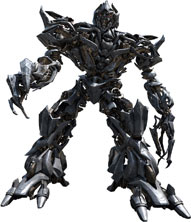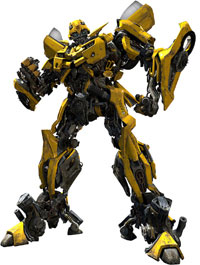Meet an Intelligent Designer of the Transformers
With news stories breaking daily, covering advances in robot technology has not been a priority for the Captain. Oh, and his spilling a can of beer down the front of ASIMO at the 2005 press event might be making access to information from the Honda folks difficult. However, that's just a guess.
 But this week he is chatting with Industrial Light & Magic's Keiji Yamaguchi, a key designer of the robots in the film "Transformers." Attention all geeks: prepare to get your freak on.
But this week he is chatting with Industrial Light & Magic's Keiji Yamaguchi, a key designer of the robots in the film "Transformers." Attention all geeks: prepare to get your freak on.
If a robot is to save mankind, then it had better look the part.
Optimus Prime, the lead robot battling evil in the film "Transformers," appeared too weak in its initial design, thought Keiji Yamaguchi, a creature developer at Industrial Light & Magic. "So I revised his face so that it looked stronger, more heroic," he says.
Perhaps a minor point to the casual filmgoer, but such detail was routine in perfecting the transformation sequences in director Michael Bay's $150 million blockbuster.
Yamaguchi, who came to ILM from Japan in 2001, was influenced by such elements as shiko, the squatting done by sumo wrestlers, and karate poses, like those of Bruce Lee, in choreographing the robots' complicated motions.
Each robot component, right down to the bolts and washers, is hand designed. A single robot has as many as 10,000 components, mostly jagged and slick hunks of metal, and when subparts are included, that number can more than double.
 In morphing the Transformers piece by piece from cars into robots and back, Yamaguchi, whose prior work included the octopuslike Kraken in "Pirates of the Caribbean: Dead Man's Chest," wanted to suit Bay's famously flamboyant tastes.
In morphing the Transformers piece by piece from cars into robots and back, Yamaguchi, whose prior work included the octopuslike Kraken in "Pirates of the Caribbean: Dead Man's Chest," wanted to suit Bay's famously flamboyant tastes.
The violent image of bosozoku -- the biker gangs that terrorize Japan's suburbs by revving their engines to ear-splitting volumes -- was a driving force.
"Instead of executing the transformations after the vehicle had stopped," he explains. "I designed the process to be ongoing as the car was skidding and spinning along the surface of the road."
Yamaguchi also wanted to make sure the animated moves had the same energy as the live-action footage.
"The camera crews were working for dear life," he says of the filming of the car sequences. "I wanted to work like the real camera crew did. We had to respect them and appreciate their spirit."
In the end, the point was to make everything look real, Yamaguchi says. "When it's all finished," he adds, "and I can see the proper rhythm, I am very pleased."
Note: This story originally appeared in the August 3rd issue of Variety.

